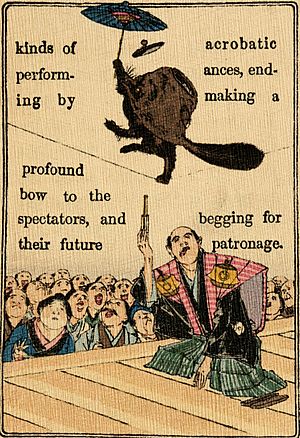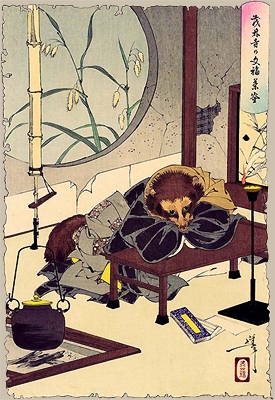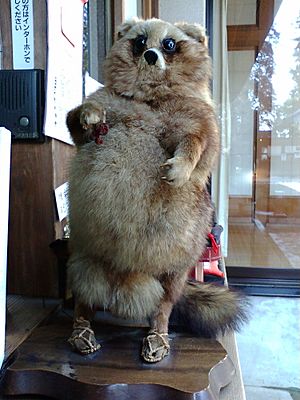Bunbuku Chagama facts for kids
Bunbuku Chagama (pronounced Boon-boo-koo Cha-ga-ma) is a famous Japanese folk tale. It's about a magical raccoon dog (called a tanuki) that can change its shape. This tanuki uses its special powers to help someone who was kind to it. The story is often called "The Wonderful Tea Kettle" or "The Accomplished and Lucky Teakettle" in English.
Contents
What is Bunbuku Chagama?
This popular Japanese fairy tale tells the story of a tanuki (raccoon dog). The tanuki can change its shape into a tea kettle. This special kettle is then sold to a person, often a priest.
In most versions of the story, the tanuki or sometimes a fox, turns into a kettle. This helps its human friend make money by selling the fake kettle. The kettle then does amazing things, like dancing or walking a tightrope.
There's also a legend about a real tea kettle named Bunbuku Chagama. This kettle was owned by a priest named Shukaku. People believed Shukaku was actually an ancient tanuki in disguise. You can still see this special kettle at Morin-ji temple in Japan.
What Does the Name Mean?
The name Bunbuku has a few possible meanings:
- One idea is that bunbuku sounds like the noise of boiling water. The word buku (or fuku) also means "good luck" or "good fortune."
- Another idea is that bunbuku can be written to mean "sharing" (bun) "wealth" or "luck" (fuku). This fits with the legend from Morin-ji temple.
- Some people think the name is actually Bunbuka. Here, bunka means a gentle flame, and buka means a strong flame.
The Fairy Tale Story
The most famous version of the story goes like this:
At a temple called Morin-ji in Japan, the head priest had a special tea kettle. One day, when the priest put the kettle on the fire, something amazing happened! The kettle suddenly grew a head, a tail, and even legs. It turned into a creature that was half-kettle and half-raccoon dog.
The priest and his young students were surprised. They managed to calm the creature, and it turned back into a normal kettle. Since it was so strange, they decided to sell it. They sold it to a traveling peddler, a person who bought and sold old things.
Later, the kettle showed its half-raccoon dog form to the peddler. The tanuki then made a deal with the peddler. It offered to perform amazing tricks if the peddler treated it well. The peddler agreed not to put it on a hot fire or keep it in a stuffy box. He also promised to share his food.
So, the peddler set up a show, like a small circus. People paid money to watch the tea-kettle tanuki walk a tightrope and dance to music. The peddler became very rich from these shows. After a while, he returned the magical kettle to the Morin-ji temple.
Different Versions of the Story
The story of Bunbuku Chagama has been told and translated many times.
- One of the first English versions was "The Accomplished and Lucky Teakettle" from 1871.
- Another popular English version was "The Wonderful Tea Kettle" published in 1886. This was part of a series of Japanese fairy tale books.
- The story is also known as "The Tea-Kettle of Good-Luck."
Sometimes, in different folk tales, a fox takes the place of the raccoon dog. But the main idea is often the same: an animal changes into a tea kettle to help a human friend. The kettle might yell when scrubbed or placed on fire, and then it performs tricks to make money for its owner.
Where Did the Story Come From?
The fairy tale is believed to come from an old legend about the Morin-ji temple in Japan. This legend tells of an amazing tea kettle that never ran out of hot water.
The Morin-ji Temple Legend
The legend says that a priest named Shukaku served at Morin-ji temple. He had been with the temple's founder since the year 1426. In 1570, during a big Buddhist event, Shukaku brought out a special tea kettle. This kettle could provide hot water day and night without running out. It was able to serve tea to over a thousand priests!
Shukaku said the kettle was called Bunbuku Chagama because it had eight special powers. It could share good fortune (fuku) and protect people from thirst. It also brought wisdom, courage, popularity, luck, and a long life.
Who Was Shukaku?
Later, rumors spread that Shukaku would sometimes grow fur on his arms and legs and even sprout a tail. Eventually, Shukaku confessed that he was actually a mujina (a type of raccoon dog or badger) who was thousands of years old! He said he had lived in India and China before coming to Japan about 800 years ago. Before he left, he showed his friends amazing visions, like a famous battle and the Buddha teaching.
This idea of an ancient animal spirit traveling from India and China is also found in other Japanese legends, like the story of the nine-tailed fox.
The Morin-ji temple itself has published books about this legend, explaining the story of Shukaku and the magical tea kettle.
Images for kids
See also
 In Spanish: Bunbuku Chagama para niños
In Spanish: Bunbuku Chagama para niños







